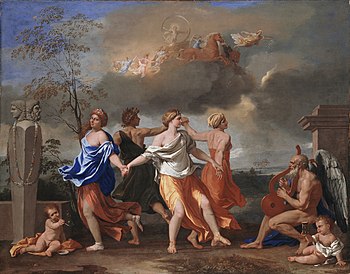A Dance to the Music of Time (painting)
| A Dance to the Music of Time | |
|---|---|
 | |
| Artist | Nicolas Poussin |
| Year | 1634-1635 |
| Medium | Oil on canvas |
| Dimensions | 82.5 cm × 104 cm (32.5 in × 41 in) |
| Location | Wallace Collection, London |
A Dance to the Music of Time is a painting by Nicolas Poussin in the Wallace Collection in London. It was painted between 1634 and 1636 as a commission for Giulio Rospigliosi (later Pope Clement IX), who according to Gian Pietro Bellori dictated its detailed iconography. It is best known for giving its name to the novel cycle of the same name, though this title is first seen in a Wallace Collection catalogue of 1913, before which it was given more prosaic titles referring to the Four Seasons. In the 1845 sale it was called La Danse des Saisons, ou l'Image de la vie humaine. It passed from the Rospigliosi family to the Fesch collection in 1806, when it was taken to France for a period, and was bought along with several other paintings by Richard Seymour-Conway, 4th Marquess of Hertford in the great Fesch sale in Rome in 1845, passing to his son Sir Richard Wallace.
Description
Four figures, holding each other by the hand, dance in a circle, as Time plays a lyre on the right. The scene is set in the early morning, with Aurora, goddess of dawn, preceding the chariot of Apollo the sun-god in the sky behind; the Hours accompany him and he holds a ring representing the Zodiac. According to Bellori, Rospigliosi's original idea was inspired by Boitet de Frauville's 'Les Dionysiaques', which describes the passing of time and the cycle of the seasons. According to this story, the god Jupiter (Greek Zeus) gave Bacchus and wine to the world in order to compensate for the miserable living conditions mortals must endure after Time and the Seasons complained. The male dancer with the crown of twigs was originally intended to represent the god Bacchus as well as the season Autumn, followed by Winter, Spring and Summer. As Poussin developed the painting, however, this theme gradually transformed into the concept of the cycle of life and fortune.
Today it is widely accepted that A Dance to the Music of Time was meant to represent the passing of time, and the different stages of life on the rapidly revolving wheel of fortune: poverty, labor, wealth, and pleasure. Poverty is the male figure at the very back of the circle, with his back turned towards the viewer. He dances barefoot, in keeping with his humble status, and looks longingly towards Labour, his dancing partner on the right. Labour, a muscular young woman also dancing barefoot whose bare shoulders and covered hair indicate her hard work, eagerly twists to grasp Wealth's hand. Wealth, dancing in golden sandals and robes, disdainfully takes Labor's hand and gazes outward with haughty self-propriety. Finally, Pleasure gazes knowingly at the viewer with a sly smirk.
This interpretation is disputed by Malcolm Bull, who relates the painting to the Romano-Greek poet Nonnus, reflected in the Hymne de l'Automme of Pierre de Ronsard. Nonnus' descriptions of the four seasons, as translated into French, are closely followed by Poussin. Bacchus himself appears, in his double aspect as a young and old figure, in the herm at left.[1]
There are several pentimenti, including the removal of a second, larger, tree on the right between Winter/Labour and Time. The painting is in generally good condition, but has been retouched in places, including over the repair of a large L-shaped tear running right through the central group.
Anthony Powell
At the start of Anthony Powell's series of novels named after the painting the narrator, Nicolas Jenkins, reflects on it in the first two pages of A Question of Upbringing:
- These classical projections, and something from the fire, suddenly suggested Poussin's scene in which the Seasons, hand in hand and facing outward, tread in rhythm to the notes of the lyre that the winged and naked greybeard plays. The image of Time brought thoughts of mortality: of human beings, facing outward like the Seasons, moving hand in hand in intricate measure, stepping slowly, methodically sometimes a trifle awkwardly, in evolutions that take recognisable shape: or breaking into seemingly meaningless gyrations, while partners disappear only to reappear again, once more giving pattern to the spectacle: unable to control the melody, unable, perhaps, to control the steps of the dance.
Notes
- ^ Bull, 259
References
- Bull, Malcolm, The Mirror of the Gods, How Renaissance Artists Rediscovered the Pagan Gods, Oxford UP, 2005, ISBN 9780195219234
Further reading
- Beresford, Richard, A Dance to the Music of Time. London: Wallace Collection (1995) ISBN 978-0-900785-46-7
- Ingamells, John, The Wallace Collection, Catalogue of Pictures, Vol III, French before 1815, London: Wallace Collection (1989) ISBN 978-0-900785-35-1
- Wallace Live - catalogue entry
